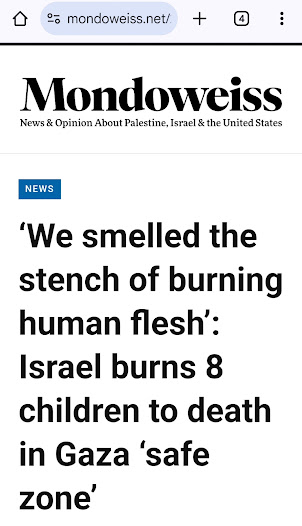On the morning of April 17, 2025, horror returned to Khan Younis. At the European Hospital, Umm Ibrahim Abu Shaar, 49, sat beside the charred bodies of her family, killed in an Israeli airstrike that struck a tent encampment in the Mawasi area—labeled a “safe zone” by the Israeli military.
The airstrike ignited a massive fire that engulfed several tents, turning them into ash within moments.
The fire was so intense that many victims were burned alive. Among the 15 bodies recovered were eight children. Witnesses described them as blackened, melted, and unrecognizable. A mother and her three children were found reduced to skeletons, their features erased by the blaze.
“We heard the explosion and saw flames erupt instantly,” said Yousef Abu al-Rus, a survivor who gave testimony to Mondoweiss. “We tried to get close, but the fire was too strong. We saw women and children burning right before our eyes—and our children saw it too.”
According to Abu al-Rus, four tents housing four families were hit by a single missile. The weapon caused a level of destruction never seen before, melting even aluminum cooking pots. “What would such a weapon do to a child barely three years old?” he asked, still in disbelief.
The victims had gone to bed the night before after attending a family wedding. Hours later, they were dead—killed in what many now describe as a deliberate targeting of civilians under the false promise of safety.
“They told us to go to the safe zone. It was a trap,” Abu al-Rus said. “We bury our children as skeletons and melted bones. Where are we supposed to go?”
This was not an isolated incident. Israeli airstrikes on April 17 continued across the Gaza Strip. The Ministry of Health in Gaza reported 40 Palestinians killed within 24 hours. The Civil Defense recovered six more bodies in Beit Lahia, where a tent sheltering displaced people was also targeted. Later that day, the al-Ayyoubiya School in North Gaza was bombed, along with residential homes throughout the strip.
Among the dead in Beit Lahia were three children from the al-Atal family, reportedly killed by a drone-fired bomb. Witnesses said the drone hovered directly over the tent before striking. “Their bodies were dismembered,” said Marwan al-Atal, a relative. “Even if someone in that tent was wanted by Israel, why kill the children too? Is this Netanyahu’s idea of military success?”
The repeated bombings of displacement camps, shelters, and schools reflect a grim reality: nowhere in Gaza is truly safe. As families flee one strike only to be killed in another, the term “safe zone” becomes not a refuge, but a cruel illusion.
The international community continues to call for accountability. Yet, for grieving families like Umm Ibrahim’s, justice remains distant. In Gaza, the fire keeps returning—and with it, the recurring question: Where can Palestinians go to be safe?

Comments